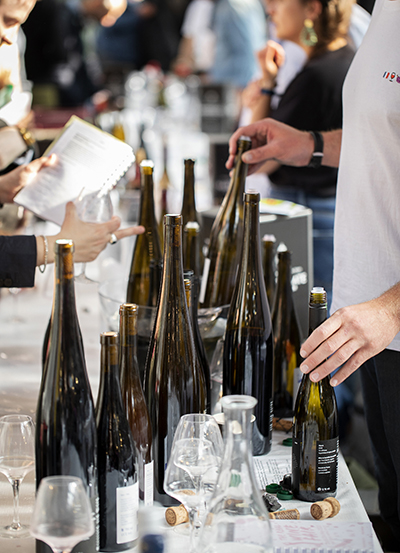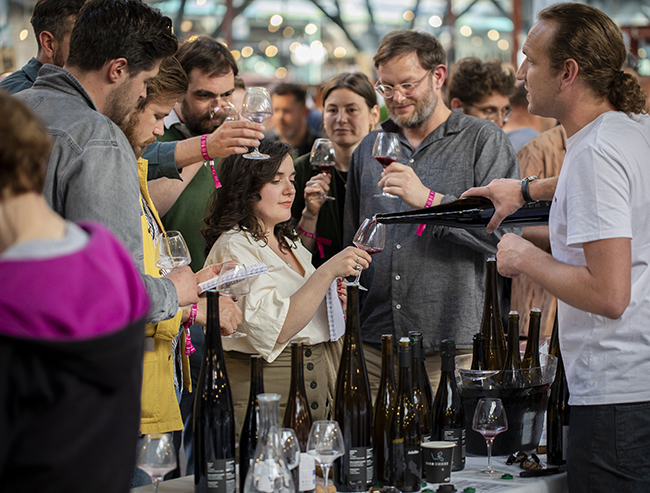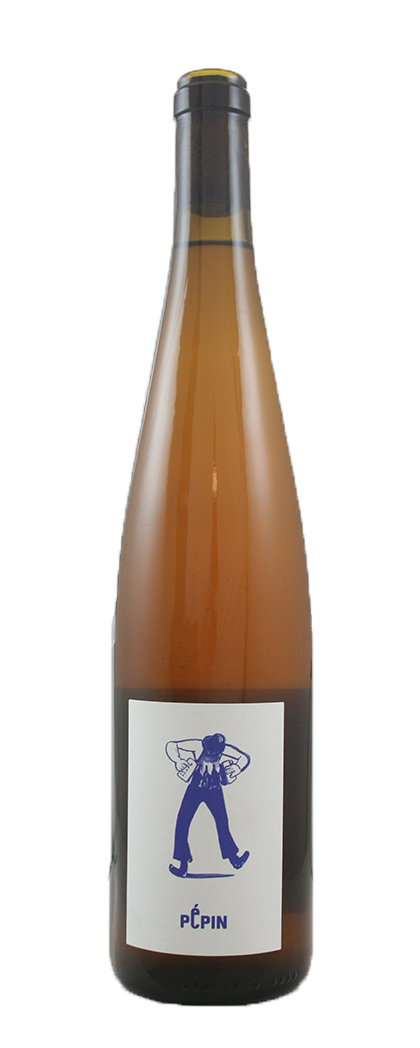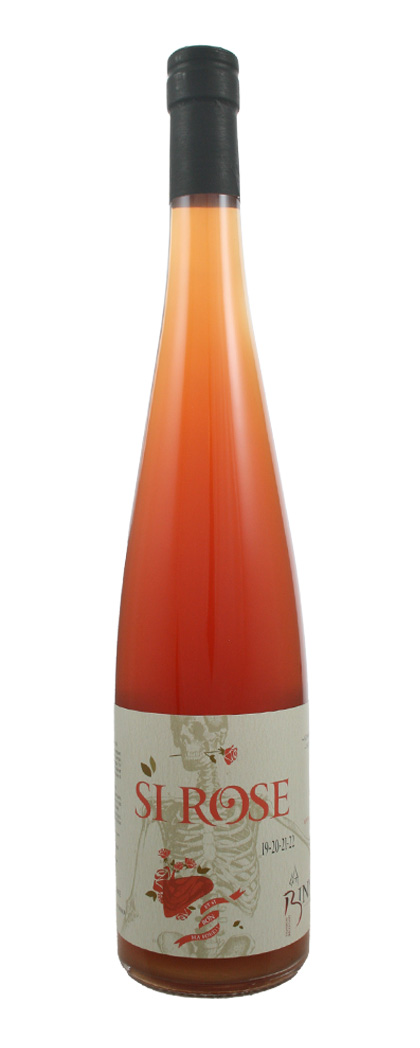The new Alsatian’s Natural Creed stateth that farming should be biodynamic and that winemaking boundaries can – and should be – pushed to the maximum minimal.
It is not just the irreverent whippersnappers bending the rules – relative veterans of their wine craft such as Jean-Pierre Frick, Bruno Schueller, Patrick Meyer and other members of the ür-gang, happily espouse madness in their methodology and make wines with extraordinary and original flavours.
Alsace is now truly a hotbed of natty wine innovation. It is not just the irreverent whippersnappers bending the rules – relative veterans of their wine craft such as Jean-Pierre Frick, Bruno Schueller, Patrick Meyer and other members of the ür-gang, happily espouse madness in their methodology and make wines with extraordinary and original flavours.

Winner winner, Christian Binner!
We begin with Christian Binner, one of the natty gangmasters. His philosophy and practice in bullet points.
- Organic practice for 15 years (although vineyards have never had chemicals) – Ecocert
- The Binners have practised biodynamics for many years using preps 500 – 507 – certified Demeter in ’20. They dynamize their own preps, and also make herbal teas to spray on the vines.
- Only ploughing on Schlossberg hill (by horse).
- Otherwise, no ploughing in the vineyards, instead loads of grassing and cover-cropping to fix the nitrogen.
- The importance of building soil structure and humus and encouraging deep root systems.
- Terraces were rebuilt on the Schlossberg to guard against soil erosion (decomposed granite).
- Alsace is the place where all the major terroirs meet! Granite mainly, but also limestone, loess, schist. Mix of shallow soils and deeper soils giving different expressions. Different expositions, of course.
- Moving to perma-and-polyculture, experimenting with pergola and planting in the shade of trees, natural vineyards without training, wires, rows. Will experiment with no pruning too.
- Christian believes that the vines naturally want to grow, and he wants to encourage this.
- He believes that doing this will eventually give his wines even more balance.
- The Binners harvest late to ensure maximal maturity.
- Totally natural – zero sulphur added to wines for the last 5 years. You can only do this when you have beautiful maturity in the grapes.
- Now a member of the Vin Nature group.
- The cellar is purpose-built. Thick earth walls keep it cool, excellent for long ambient fermentations.
- All wines are aged on their lees in foudres of around 100 years old. The oldest dates back to 1899.
- Always topping up the barrels. Bacterial problems tend to arise towards the top of the barrel, rather than in the wine itself.
- Aiming for maximum intensity, natural ripeness, vinifying to dry.
- His wines are always gastronomic (intense, full).
- He’s creating a solera system for Si Rose (a blend of Gewürztraminer Rose & Pinot Gris – the current edition features 2019-22 inclusive).
- He says that Alsace is the logical heart of France for skin-contact wines. The aromatic grapes such as Gewürztraminer, Pinot Gris and Muscat lend themselves to this and the bitterness gives structure and definition to the wines.
The wine under review: Si Rose – a skin-contact wine by any other name, a rose is a rose is a rose, but not a rosé
I am contractually obliged NOT to write any articles on rosé wines this summer in case I tempt fate and send the weather patterns into a low pressure tailspin. Si was made by blending four vintages in equal proportions, 2019, 2020, 2021 and 2022. Proportions of grapes, vintages and length of maceration is entirely dependent on the nature of the vintage. The maceration, fermentation and the ageing took place in the estate’s one-hundred-year-old oak barrels, sans temperature control, in Binner’s brand-new bioclimactic winery. Christian comments: “Even in Roman times white wines were macerated in this way, releasing tannins and colour, the natural anti-oxidants of grapes”. After this the wine is matured for a further period on the lees before bottling without filtration or sulphur added.
As Christian comments: “Si Rose is the result of the observation that the Gewurztraminer and Pinot Gris grapes, given the global warming that Alsace is undergoing, find their limit in classic white wine making. I was therefore inspired by the experience of the Mediterranean countries, Italy, Slovenia, Croatia, and Georgia, which historically, have been able to vinify fleshy and powerful grape varieties in hot countries, to make fresh, gourmet and palatable wines. Their secret: macerated whites, making it an orange wine.”
The rose referred to is the fact that this Gewürztraminer possesses the aroma of the rose.
Difficult to describe the taste of a wine that seems to vanish from the glass as soon as you pour it! Suffice to say, there are notes of roses, peaches (blossom and fruit), pink grapefruit, playful mingling between ripeness and citrus, all flavoured with pepper, dried spice, herbs and crushed minerals. The pleasure is all yours. The wine glows.
Frickishly good

I have written about Jean-Pierre Frick and his wines on many occasions. If your palate is accustomed to clean and clean-lined wines, then JP’s wines will provide a three-dimensional shock to the system. It is very difficult to describe them other than in terms of textures that change by the minute. Products of slow oxidative ageing, the wines become golden-amber, and the interplay of flavours occurs in the tasting-note spectrum of sun-ripened orchard fruits, warm walnut cream and sweet spices. Language doesn’t do justice though to the living liquid; you need to develop an unspoken relationship with the wines over the course of a bottle.
Jean-Pierre is not dogmatist as much as a cerebral thinker and constant experimenter.
The wines under review: Pinot Blanc Sans Soufre & Sylvaner Bergweingarten
Two labels arrived recently. One a Pinot Blanc Sans Soufre, the second Sylvaner Bergweingarten. The Pinot Blanc reminds one of a Jura Chardonnay. As Pinot B tends to be, it is the opposite of aromatic. It is both multi-layered and vivid in every sense and deserving of serious food. The Sylvaner vintage (2016) is a follow on from the 2012 which we enjoyed enormously. Very exotic with discernible residual sugar, it sports a touch of botrytis. I drank a glass on the first day and found it difficult to love. On the second day, the wine was gorgeous. If anything, it had shed the primary puppy fat fruit and had become wholesome and integrated.
Jean-Pierre is not dogmatist as much as a cerebral thinker and constant experimenter. One feels that each wine develops according to its merits and when he feels that it is right to push the envelope, he takes the knowing risk. In the end, he doesn’t add much in the way of sulphites to his wines, for example, but the sans soufre wines tend to be more thrilling and vibrating with energy.
Pepin talk a.k.a The Crying of Lot etc etc

Do you have guilty wine pleasures? I do. A friend of mine, who happens to be a natural wine aficionado with a fantastically precise palate, loves the taste of old-fashioned tawny Rioja. When going out to my local Greek restaurant, I always order the house retsina. I relish that turpentine/linseed oil flavour chilled to distraction. For my sins, I also adore Gewürztraminer, even the cheap stuff that smells like lavender palm cream. This week, my favourite wine was an amber Gewürz from biodynamic natural producer Pepin (a Dietrich family project in Alsace). Blended with other grapes, the Gewürz was the over-rider, an exotic fruit salad of peach, orange flower water and cloves. Like a cocktail. Not subtle– in fact quite obvious–but I loved it. Sometimes, you just want to drink something to make you smile. So excommunicate me!
Coordinated by Pierre Dietrich (of Domaine de l’Achillée), Pépin is a project that works closely with several small Alsatian winegrowers with the collaboration running from grape growing right through to vinification, the aim is to make cracking and affordable natural wines. The growers are all friends, and each have been working organically for many years. This is why the batches follow each other and do not know the state of rupture.
The wine under review: Pépin Orange
In the whites, we mainly find Riesling, Pinot Gris, Pinot Blanc, Sylvaner and Chardonnay in particular, which gives a beautiful fruity frame to thirsty wines. In an orange wine, you may discover Auxerrois, Sylvaner, Muscat & Gewürztraminer. From batch to batch, the content and the winemaker may change but the ethos and the label remains the same, so customers can have a white/orange wine that meets the same expectations all year round. By their Lot numbers shall ye know them. And there are a lot of lots. If you are a sucker for knowing grape blends, then you will find succour of information delivered on the back labels. But the aim is to create a taste gateway for natural wines in general – and Alsace natural wines in particular. The latest orange lot is 100% Gewürz, which is where we came in. Think roses and peach(blossom) with orange zest and juice. Alsace wines can be fun too!
By their Lot numbers shall ye know them. And there are a lot of lots. If you are a sucker for knowing grape blends, then you will find succour of information delivered on the back labels. But the aim is to create a taste gateway for natural wines in general – and Alsace natural wines in particular. The latest orange lot is 100% Gewürz, which is where we came in. Think roses and peach(blossom) with orange zest and juice. Alsace wines can be fun too!
*
Interested in finding out more about the wines of Alsace? Contact us directly:
shop@lescaves.co.uk | sales@lescaves.co.uk | 01483 538820


